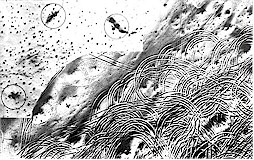
The Battle of Longewala was one of the first major engagements in the western sector during the Indo-Pakistani War of 1971, fought between assaulting Pakistani forces and Indian defenders at the Indian border post of Longewala, in the Thar Desert of Rajasthan. The battle was fought between 120 Indian soldiers accompanied by four Hawker Hunter and three HAL Marut fighter-bombers and 2,000–3,000 Pakistani soldiers accompanied by 30–40 tanks.
39th Indian Infantry Division was an infantry division of the Indian Army during World War II, which became a training division in 1943 after its recovery into India from Burma. The division was re-raised after independence and 39 Mountain Division is presently located in Palampur, Himachal Pradesh under XVI Corps.

Tikka Khan was a Pakistani military officer who served as the first chief of the army staff from 1972 to 1976. Along with Yahya Khan, he is considered a chief architect of the 1971 Bangladesh genocide that resulted in the deaths of up to 3,000,000 people. His leadership of the Pakistani Army actions in Bangladesh led to him being dubbed the "Butcher of Bengal" by Bengalis.
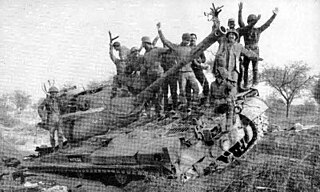
The Battle of Basantar, also known as the Battle of Shakargarh or Battle of Barapind, was one of the vital battles fought as part of the Indo-Pakistani War of 1971 in the western sector of India. The Indian troops won a hard-fought battle that secured this area in the Punjab/Jammu sector. The name Battle of Basantar actually encompasses the entire gamut of battles and skirmishes fought in the Shakargarh sector.
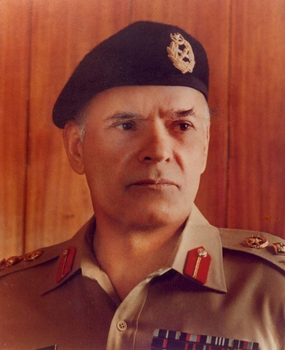
Akhtar Abdur Rahman, was a Pakistan Army general who served as the 5th Chairman Joint Chiefs of Staff Committee from 1987 until his death in 1988. He previously served as the 12th Director-General of Inter-Services Intelligence from 1979 to 1987. During both Indo Pak wars of 1965 and 1971, he oversaw action with his own unit 45 Field Regiment Artillery in Sundra and Hussainiwala sectors respectively.

The 10 RAPID Division was a war formed infantry division of the Indian Army during World War II. In four years, the division travelled over 4,000 miles (6,400 km) from Tehran to Trieste, fought three small wars, and fought two great campaigns: the Anglo-Iraqi War, the Invasion of Syria–Lebanon, the Anglo-Soviet invasion of Iran, the North African Campaign, and the Italian Campaign.
Operation Cactus Lilly, better known as The Meghna Heli Bridge or the Crossing of the Meghna, was an air assault operation conducted between 9 and 12 December 1971 during the Indo-Pakistani War of 1971. It was conducted by the Indian Army and Indian Air Force to cross the Meghna River, bypass a Pakistani stronghold at Ashuganj/Bhairab Bazar and reach Dhaka. The operation is generally regarded as the brainchild of Maj. Gen. Sagat Singh. Without it, Indian forces would not have been able to complete the encirclement of Dhaka and it would likely have led to a lengthening of the war.
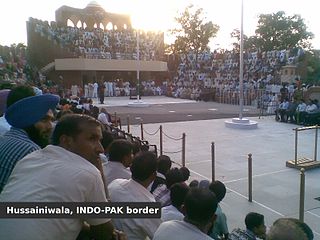
Hussainiwala is a village near Firozpur city in Firozpur district in Punjab state, India. It lies near the bank of the Sutlej river. The village is on the border with Pakistan, opposite the Pakistani village of Ganda Singh Wala. It is a border crossing between India and Pakistan that is currently closed, however a daily joint beating retreat border ceremony is held by the two nations. The village is popular for the Hussainiwala National Martyrs Memorial.

Kaser-e-Hind or Qaser-i-Hind is a citadel in the Indian state of Punjab. The fortress was briefly occupied by Pakistani military and was later returned to India after the end of 1971 India-Pakistan War. 41 Baloch Regiment and 45 Field Regiment Pakistan Artillery were awarded battle honours for their tremendous and bold victory over the citadel.

Tamgha-i-Jurat, is the fourth highest military award of Pakistan. This citation is awarded for extraordinary heroism while engaged in armed combat with an opposing force on Pakistan soil or outside its borders. The award was established in 1957 after Pakistan became a republic, however, it was instituted retrospectively back to 1947. This medal is awarded for various types of high risk tactical missions like combat, tactical reconnaissance and infiltration and can be bestowed upon all ranks, commissioned officers and non-commissioned officers, in the Pakistan Army, Navy, Air Force, and the paramilitary Civil Armed Forces such as the Frontier Corps, the Frontier Constabulary and the Pakistan Rangers. Ranked below the Sitara-i-Jurat on the order of precedence, the Tamgha-i-Jurat is the equivalent to the Military Cross in the U.K Commonwealth honours system and the Silver Star in the United States honours system.
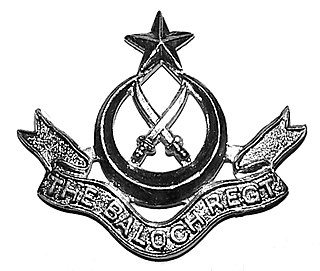
The Baloch Regiment is an infantry regiment of the Pakistan Army. The modern regiment was formed in May 1956 by the merger of 8th Punjab and Bahawalpur Regiments with the Baluch Regiment. Since then, further raisings have brought the strength of the Regiment to 27 battalions. The Baloch Regiment is descended from the infantry of the old British Indian Army and is named after Balochistan. Before 1991, it was called the Baluch Regiment but the spelling was changed to 'Baloch' to better reflect the correct pronunciation.
The 11th Infantry Division is an active formation of the Pakistan Army. It is currently deployed in Lahore as part of IV Corps, and is responsible for the defence of that city and the surrounding areas.

The 15th Indian Division was an infantry division of the British Indian Army that saw active service in the First World War. It served in the Mesopotamian Campaign on the Euphrates Front throughout its existence. It did not serve in the Second World War, but was reformed at Dehradun in 1964 as part of the post-independence Indian Army.
On 25 March 1971, the Pakistani military, supported by paramilitary units, launched the military operation to pacify the insurgent-held areas of East Pakistan, which led to a prolonged conflict with the Bengali Mukti Bahini. Although conventional in nature during March–May 1971, it soon turned into a guerrilla insurgency from June of that year. Indian Army had not directly supported the Bengali resistance but had launched Operation Jackpot to support the insurgency from May 1971.
The Defence of Kamalpur was a second battle fought over Kamalpur near the border between India and East Pakistan during the Bangladesh War of Independence. Kamalpur, a hamlet on the border, was defended by 60-70 regular and paramilitary Pakistani soldiers under the command of Captain Ahsan Malik.

Ahsan Siddique MalikSJ SI(M) is a retired Pakistan Army officer who defended Kamalpur in the Indo-Pakistani War of 1971. He held the rank of Captain at the time, serving in the 31st Battalion, Baloch Regiment.

The Eastern Command of the Pakistan Army was a corps-sized military formation headed by a lieutenant-general, who was designated the Commander Eastern Command. After the partition of India by United Kingdom, the Islamic Republic of Pakistan was divided into two territories separated by 1,000 miles (1,600 km). Most of the assets of the Pakistan armed forces were stationed in West Pakistan; the role of the Pakistan armed forces in East Pakistan was to hold that part of the country until the Pakistani forces defeated India in the west. The Pakistan Army created the Eastern Command, with one commander in the rank of Lieutenant General responsible for the command. The armed forces, had drawn up a plan to defend Dhaka by concentrating all their forces along the Dhaka Bowl.

19th Battalion The Baloch Regiment is one of the oldest Light Anti-Tank Regiment of Pakistan Army. Initially raised as the Machine Gun Battalion of 10th Baluch Regiment in 1942, it was first designated as 53rd Regiment, Indian Armoured Corps and then re-designated as 17/10th Baluch. This unit has the unique honour of being the parent unit of Pakistan Army's special forces known as Special Service Group. Prominent officers including General Mirza Aslam Beg, General Pervez Musharraf have served in the unit and Maj Gen Abrar Hussain and Maj Gen Aboobaker Osman Mitha also known as AO Mitha have commanded this unit.

The Jalandhar–Firozpur line is a railway line connecting Jalandhar City and Firozpur Cantonment, both in the Indian state of the Punjab. The line is under the administrative jurisdiction of Northern Railway.
Colonel Shafqat Baloch SJ, best known as Major Shafqat Baloch, was a Pakistani military officer who is known as the "Saviour of Lahore" for his gallantry and actions of valor during the Second Indo-Pakistani War of 1965. He was awarded the Sitara-e-Jurat two times, first in 1965 and second in 1971.
















